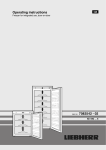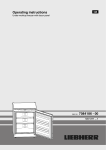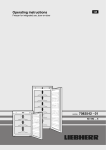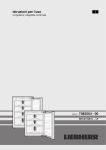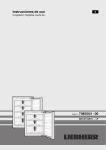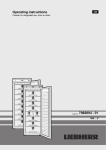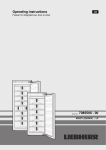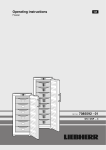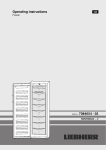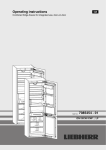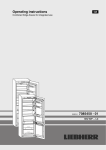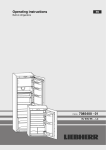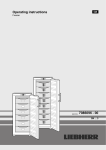Download Liebherr IGN 1654 Premium
Transcript
Operating instructions Freezer for integrated use, door-on-door 121113 7085564 - 00 IGN10/ IGN16 ... LP Appliance at a glance 1 Appliance at a glance Contents 1 1.1 1.2 1.3 1.4 Appliance at a glance............................................ Description of appliance and equipment.................. Range of appliance use............................................ Conformity................................................................ Saving energy.......................................................... 2 2 2 3 3 2 General safety information................................... 3 3 3.1 3.2 Controls and displays........................................... Operating and control elements............................... Temperature display................................................. 4 4 4 4 4.1 Putting into operation............................................ Switching on the appliance....................................... 4 4 5 5.1 5.2 5.3 5.4 5.5 5.6 5.7 5.8 5.9 5.10 5.11 5.12 Control.................................................................... Child proofing........................................................... Door alarm................................................................ Temperature alarm................................................... Freezing food........................................................... Thawing food............................................................ Setting the temperature............................................ SuperFrost............................................................... Drawers.................................................................... Shelves.................................................................... VarioSpace............................................................... Information system................................................... Cold storage accumulators....................................... 4 4 5 5 5 5 5 5 6 6 6 6 6 6 6.1 6.2 6.3 Maintenance........................................................... Defrosting with NoFrost............................................ Cleaning the appliance............................................. Customer service..................................................... 6 6 6 7 7 Malfunction............................................................. 7 8 8.1 8.2 Decommissioning.................................................. Switching off the appliance....................................... Taking the appliance out of service.......................... 8 8 8 9 Disposing of the appliance................................... 8 The manufacturer works constantly on the further development of all the types and models. Therefore please understand that we have to reserve the right to make design, equipment and technical modifications. To get to know all the benefits of your new appliance, please read the information contained in these instructions carefully. The instructions apply to several models. Differences may occur. Text relating only to specific appliances is marked with an asterisk (*). Instructions for action are marked with a action are marked with a . 2 , the results of 1.1 Description of appliance and equipment (1) Operating and control elements (2) Cold storage accumulator (3) Information system (4) Drawers Fig. 1 (5) VarioSpace (6) Type plate (7) Soft stop mechanism (8) Height-adjustable feet Note u Shelves, drawers and baskets are arranged for optimum energy efficiency on delivery. 1.2 Range of appliance use The appliance is suitable solely for cooling food in a domestic environment or similar. This includes use in, for example - in staff kitchenettes, bed and breakfast establishments, - by guests in country homes, hotels, motels and other forms of accommodation, - in catering and similar services in the wholesale trade Use the appliance solely as is customary within a domestic environment. All other types of use are inadmissible. The appliance is not suitable for storing and cooling medicines, blood plasma, laboratory preparations or similar substances and products covered by the 2007/47/EC Medical Devices Directive. Misuse of the appliance can result in the stored products suffering harm or perishing. Furthermore, the appliance is not suitable for operation in potentially explosive atmospheres. The appliance is set to operate within specific ambient temperature limits according to its climate rating. The correct climate rating for your appliance is indicated on the type plate. * Depending on model and options General safety information - Do not damage the mains power cable. Do Note not operate the appliance with a defective uCompliance with the ambient temperatures mains power cable. indicated is required, otherwise the cooling Have any repairs to or intervention in the performance is reduced. appliance, and any change of the mains power cable, carried out by the customer Climate for ambient temperatures rating service only or by other specialised personnel trained for the purpose. SN, N up to 32 °C - Only install, connect and dispose of the appliST up to 38 °C ance according to the instructions. T up to 43 °C - Only use the appliance when it is installed. The appliance will function properly in ambient - Please keep these instructions in a safe place and pass them on to any subsequent owners. temperatures of down to 5 °C. Fire hazard: 1.3 Conformity - The refrigerant R 600a is environmentally The refrigerant circuit is tested for leakage. When built-in the friendly but flammable. Escaping refrigerant appliance complies with the relevant safety regulations and EC may ignite. Directives 2006/95/EC, 2004/108/EC, 2009/125/EC and • Do not damage the refrigerant circuit pipes. 2010/30/EU. • Do not allow naked flames or ignition Note for test institutions: sources to enter the appliance. Tests are to be carried out according to the applicable • Do not use any electrical appliances in the standards and guidelines. Preparation and testing of the appliances must be carried interior (e.g. steam cleaners, heaters, ice out taking the manufacturer's loading plans and the cream maker etc.). notes in the operating manual into account. • If refrigerant escapes: remove any naked flames or sources of ignition from the 1.4 Saving energy leakage area. Ventilate the room well. - Always ensure good ventilation. Do not cover ventilation Notify the after-sales service. openings or grille. Do not store explosives or sprays using - Do not place appliance in areas of direct sunlight or next to a stove, heater or similar object. combustible propellants such as butane, - The energy consumption depends on the installation condipropane, pentane, etc. in the appliance. To tions, e.g. the ambient temperature (see 1.2) . identify these spray cans, look for the list of - Keep the time the appliance is open to a minimum. contents printed on the can, or a flame - The lower the temperature setting, the higher the power consumption. symbol. Gases possibly escaping may ignite - Store food logically. (see Appliance at a glance). due to electrical components. - Ensure that all food is well packed and covered for storage. - Please be sure to store alcoholic drinks or This will prevent frost from forming. other packaging containing alcohol in tightly - First cool warm food to room temperature before storing it . closed containers. Any alcohol that leaks out may be ignited by electrical components. 2 General safety information Danger of tipping and falling: Danger for the user: - Do not misuse the plinth, drawers, doors etc. - This appliance can be used by children of 8 as a step or for support. This applies particuyears old and over, and also by persons with larly to children. restricted physical, sensory or mental Danger of food poisoning: capacity or lack of experience and knowl- Do not consume food which has been stored edge, if they are supervised or have been too long. instructed on safe use of the appliance and understand the resulting risks. Children must Danger of frostbite, numbness and pain: not be allowed to play with the appliance. - Avoid lasting skin contact with cold surfaces or refrigerated/frozen food or take protective Cleaning and user maintenance must not be steps, e.g. wear gloves. Do not consume ice carried out by children without supervision. - When disconnecting the appliance from the cream, water ice or ice cubes immediately and do not consume them too cold. supply, always take hold of the plug. Do not pull the cable. Danger of injury and damage: - In the event of a fault pull out the mains plug or deactivate the fuse. * Depending on model and options 3 Controls and displays - Hot steam can lead to injury. Do not use elec- - the freezer temperature is above 0 °C. trical heating or steam cleaning equipment, The following displays indicate malfunction. Possible and corrective action (see Malfunction). open flames or defrosting sprays to defrost. - Do not use sharp implements to remove the - F0 to F9 ice. The power failure symbol shines. Risk of crushing - Do not reach into the soft stop mechanism. 4 Putting into operation Fingers may be trapped when the door is closed. 4.1 Switching on the appliance Please observe the specific information in u Open the door. the other sections: u Press the On/Off button Fig. 2 (1). DANGER identifies a situation involving direct danger which, if not obviated, may result in death or severe bodily injury. w The temperature display lights up. The appliance is switched on. w If “DEMO” is displayed, demo mode is activated. Please contact the after sales service. WARNING identifies a dangerous situation which, if not obviated, may result in death or severe bodily injury. 5 Control CAUTION identifies a dangerous situation which, if not obviated, may result in minor or medium bodily injury. NOTICE Note identifies a dangerous situation which, if not obviated, may result in damage to property. identifies useful information and tips. 3 Controls and displays 3.1 Operating and control elements causes 5.1 Child proofing The child-proofing function enables you to make sure that the appliance is not inadvertently switched off by playing children. 5.1.1 Setting the child lock To switch on the function: u Activate setting mode: press the SuperFrost button Fig. 2 (4) for approx. 5 seconds. w The Menu symbol Fig. 2 (8) is shown on the display. w c flashes on the display. u Briefly confirm with the SuperFrost button, Fig. 2 (4). w c1 appears in the display. u Briefly confirm with the SuperFrost button, Fig. 2 (4). w The child lock symbol Fig. 2 (9), lights up on the display. w c flashes on the display. w The child lock function is switched on. If setting mode is to be terminated: u Briefly press the On/Off button Fig. 2 (1). -oru Wait for 5 minutes. Fig. 2 (1) On/Off button (2) Temperature display (3) Up/Down button (4) SuperFrost button (5) SuperFrost symbol (6) Alarm button (7) Alarm symbol (8) Menu symbol (9) Child lock symbol (10) Power failure symbol 3.2 Temperature display The following are displayed in normal operation: - the warmest freezing temperature The temperature display flashes: - the temperature setting is being changed - after switch-on the temperature is not yet cold enough - the temperature has risen several degrees w The temperature display shows the temperature again. To switch off the function: u Activate setting mode: press the SuperFrost button Fig. 2 (4) for approx. 5 seconds. w The Menu symbol Fig. 2 (8) is shown on the display. w c flashes on the display. u Briefly confirm with the SuperFrost button, Fig. 2 (4). w c0 appears in the display. u Briefly confirm with the SuperFrost button, Fig. 2 (4). w The child lock symbol Fig. 2 (9) goes out. w c flashes on the display. w The child lock function is switched off. If setting mode is to be terminated: u Briefly press the On/Off button Fig. 2 (1). -oru Wait for 5 minutes. w The temperature display shows the temperature again. Dashes flash in the display: 4 * Depending on model and options Control 5.2 Door alarm 5.5 Thawing food If the door is open for longer than 60 seconds, the audible warning will sound. The audible alarm is automatically silenced when the door is closed. u 5.2.1 Muting the door alarm The audible alarm can be muted when the door is open. The sound switch-off function is active as long as the door is left open. u Press alarm button Fig. 2 (6). w The door alarm is silenced. 5.3 Temperature alarm The audible alarm sounds if the freezer temperature is not cold enough. The temperature display and the alarm symbol Fig. 2 (7) flash at the same time. The cause of the temperature being too high may be: - warm fresh food was placed inside - too much warm ambient air flowed in when rearranging and removing food - power failure for some time - the appliance is faulty The audible alarm is automatically silenced, the alarm symbol Fig. 2 (7) goes out and the temperature display stops flashing when the temperature is sufficiently cold again. If the alarm status persists: (see Malfunction). Note Food may be spoilt if the temperature is not cold enough. u Check the quality of the food. Do not consume spoiled food. 5.3.1 Muting the temperature alarm The audible alarm can be muted. When the temperature is sufficiently cold again, the alarm function is active again. u Press alarm button Fig. 2 (6). w The audible alarm is silenced. 5.4 Freezing food The rating plate indicates the maximum quantity of fresh food you can freeze within 24 hours (see Appliance at a glance) under “Freezing capacity ... kg/24h”. The maximum load of frozen food for the drawers is 25 kg each and for the shelves 35 kg each. A vacuum is generated after the door is closed. After closing the door, wait for about 1 minute and then it opens more easily. CAUTION Risk of injury due to broken glass! Bottles and cans containing drinks may burst when being frozen. This applies particularly to sparkling drinks. u Do not freeze bottles and cans containing drinks! In order that the food is rapidly frozen through to the core, do not exceed the following quantities per pack: - Fruit, vegetables up to 1 kg - Meat up to 2.5 kg u Pack the food in portions in freezer bags, reusable plastic, metal or aluminium containers. * Depending on model and options at room temperature in a microwave oven in a conventional or fan oven Remove only as much food as is required. Use thawed food as quickly as possible. u Food once thawed should be re-frozen only in exceptional cases. 5.6 Setting the temperature The temperature depends on the following factors: - the frequency of opening the door - the room temperature of the installation location - the type, temperature and quantity of the food Recommended temperature setting: -18 °C The temperature can be adjusted continually. Once the -28 °C setting is reached, the sequence starts again at -15 °C . u Call up the temperature function by pressing the adjustment button Fig. 2 (3) once. w The previously-set value will flash in the temperature display. u Change temperature in 1 °C steps: press the setting button () until the required temperature is indicated in the temperature display. u Change temperature continually: hold down setting button. w During adjustment the value flashes on the display. w The new setting is adopted approx. 5 seconds after the last time the button was pressed and the set temperature is again displayed. The temperature in the interior gradually adjusts to the new value. 5.7 SuperFrost With this function you can freeze fresh food quickly through to the core. The appliance operates with maximum refrigeration. The noise of the refrigeration unit may be temporarily louder as a result. The maximum amount of fresh food which can be frozen in 24 h is indicated on the type plate under “freezing capacity ... kg/ 24h”. This amount varies according to the model and climate rating. You have to activate SuperFrost in good time, depending on how much fresh food is to be frozen: about 6 hours before placing the food inside in case of small amounts and about 24 hours in advance in case of the maximum amount of food to be frozen. Wrap produce and spread it out as far as possible. Do not allow produce to be frozen to touch produce that is already frozen to prevent the latter thawing. You do not have to activate SuperFrost in the following cases: - when placing frozen food in the freezer - when freezing up to approx. 2 kg fresh food daily 5.7.1 Freezing with SuperFrost u Briefly press the SuperFrost button Fig. 2 (4) once. w The SuperFrost symbol Fig. 2 (5) shines. w The freezing temperature drops, the appliance operates with the maximum cooling capacity. For a smaller quantity of produce to be frozen: u wait approx. 6 h. u Place wrapped produce in the deep bottom drawers. For the maximum quantity of produce to be frozen: u wait approx. 24 h. u Remove the deep bottom drawers and place produce directly on the bottom shelves. w SuperFrost is automatically deactivated after 65 hours. 5 Maintenance w The SuperFrost symbol Fig. 2 (5) extinguishes once freezing is completed. u Place produce in the drawers and push the latter back in again. w The appliance continues to operate in the energy-saving, normal mode. 5.11 Information system 5.8 Drawers Note The energy consumption increases and the cooling performance reduces if the air ventilation is insufficient. u Ensure that the air slits of the fan on the rear wall are always kept free! Fig. 3 (1) Ready meals, ice cream (4) Sausage, bread (2) Pork, fish (5) Game, mushrooms (3) Fruit, vegetables (6) Poultry, beef / veal The figures indicate the storage time in months for several types of frozen food in each case. Storage times given are guide times. 5.12 Cold storage accumulators The cold storage accumulators prevent the temperature from rising too fast in the event of power failure. 5.12.1 Using cold storage accumulators u To store frozen food directly on the shelves: pull the drawer forwards and lift it out. 5.9 Shelves u Place the frozen cold storage accumulators on the frozen food in the upper front area of the freezer compartment. 5.9.1 Moving shelves u To remove the shelf: lift up at the front and pull out. u To put the shelf back: simply push in as far as it will go. 5.9.2 Removing shelves 6 Maintenance 6.1 Defrosting with NoFrost The NoFrost system automatically defrosts the appliance. The moisture condenses on the evaporator, is periodically defrosted and evaporates. u The appliance does not have to be manually defrosted. 6.2 Cleaning the appliance WARNING Risk of injury and damage as a result of hot steam! Hot steam can lead to burns and can damage the surfaces. u Do not use any steam cleaners! u The shelves may be removed for cleaning. 5.10 VarioSpace Apart from being able to remove the drawers, you can also remove the shelves, creating space for large items of frozen food. Poultry, meat, large pieces of game and high bakery products can be frozen in one piece and prepared. u The maximum load of frozen food for the drawers is 25 kg each and for the shelves 35 kg each. 6 NOTICE Incorrect cleaning damages the appliance! u Do not use cleaning agents in concentrated form. u Do not use any scouring or abrasive sponges or steel wool. u Please do not use any aggressive, scouring, sand-, chloride-, chemical- or acid-based cleaning agents. u Do not use chemical solvents. u Do not damage or remove the type plate on the inside of the appliance. It is important for the customer service. u Do not pull off, bend or damage cables or other components. u Do not allow any cleaning water to enter the drain channel, ventilation grille or electrical parts. u Please use soft cleaning cloths and a universal pH-neutral cleaning agent. u Please use cleaning and care products suitable for contact with foodstuffs in the appliance interior. * Depending on model and options Malfunction u Empty appliance. u Pull out the power plug. The compressor runs for a long time. → The compressor switches to a low speed when little cold is u Clean the vent grille regularly. w Dust deposits increase energy consumption. u Clean plastic outer and inner surfaces with lukewarm water and a little washing-up liquid. u Clean items of equipment by hand with lukewarm water and a little washing-up liquid. After cleaning: u Wipe dry the appliance and items of equipment. u Connect the appliance and switch it on again. u Switch on SuperFrost (see 5.7) . When the temperature is sufficiently cold: u Put the food back inside. 6.3 Customer service Excessive noise. → Due to the various speed steps, speed-regulated* compressors can generate different running noises. u The sound is normal. A bubbling and gurgling noise. First check whether you can correct the fault yourself by reference to the list (see Malfunction). If this is not the case, please contact the customer service whose address is given in the enclosed customer service list. WARNING Risk of injury if repair work is not carried out professionally! u Have any repairs and action - not expressly specified - on the appliance and mains cable carried out by service personnel only. (see Maintenance) u Read the appliance designation Fig. 4 (1), service No. Fig. 4 (2) and serial No. Fig. 4 (3) off the type plate located inside the appliance on the lefthand side. → This noise comes from the refrigerant flowing in the refrigeration circuit. u The sound is normal. A quiet clicking noise. → The noise is produced whenever the refrigeration unit (motor) automatically switches on or off. u The sound is normal. A hum. It is briefly a little louder when the refrigeration unit (the motor) switches on. → The refrigeration increases automatically when the SuperFrost, function is activated, fresh food has just been placed in the appliance or the door has been left open for a while. u The sound is normal. → The ambient temperature is too high. u Solution: (see 1.2) A low hum. → The sound is produced by air flow noise of the fan. u The sound is normal. Fig. 4 u Notify the customer service, specifying the fault, appliance designation Fig. 4 (1), service No. Fig. 4 (2) and serial No. Fig. 4 (3). w This will help us to provide you with a faster and more accurate service. u Keep the appliance closed until the customer service arrives. w The food will stay cool longer. u Pull out the mains plug (not by pulling the connecting cable) or switch off the fuse. 7 Malfunction Your appliance is designed and manufactured for a long life span and reliable operation. If a malfunction nonetheless occurs during operation, check whether it is due to a handling error. In this case you will have to be charged for the costs incurred, even during the warranty period. You may be able to rectify the following faults yourself: Appliance does not work. → The appliance is not switched on. u Switch on the appliance. → The power plug is not properly inserted in the wall socket. u Check power plug. → The fuse of the wall socket is not in order. u Check fuse. * Depending on model and options needed. Although the running time is increased as a result, energy is saved. u This is normal in energy-saving models. → SuperFrost is activated. u The compressor runs for longer in order to rapidly cool the food. This is normal. A LED on the bottom rear of the appliance (at the compressor) flashes repeatedly every 5 seconds*. → There is a fault. u Please contact the after-sales service (see Maintenance). Vibratory noise. → The appliance is not fixed to the ground. The running of the cooling unit therefore makes objects and adjacent furniture vibrate. u Check installation and reposition appliance as required. u Move bottles and containers apart. Flow sound at the soft stop mechanism. → The noise is produced when the door is opened and closed. u The sound is normal. The temperature display indicates: F0 to F9 → There is a fault. u Please contact the after-sales service (see Maintenance). The temperature display indicates power failure . The warmest temperature reached during the power failure appears in the temperature display. → The freezer temperature rose too high over the last hours or days due to a power failure or power interruption. When the power interruption is over, the appliance will continue to operate in the last temperature setting. u To cancel the display of the warmest temperature: press alarm button Fig. 2 (6). u Check the quality of the food. Do not consume spoiled food. Do not re-freeze thawed food. DEMO shines in the temperature display. → The demo mode is activated. u Please contact the after-sales service (see Maintenance). The outer surfaces of the appliance are warm*. → The heat of the refrigeration circuit is used to prevent condensate from forming. 7 Decommissioning u This is normal. The temperature is not cold enough. → The door of the appliance is not properly closed. u Close the door of the appliance. → Insufficient ventilation. u Clear ventilation grilles. → The ambient temperature is too high. u Solution: (see 1.2) . → The appliance was opened too frequently or for too long. u Wait to see whether the appliance reaches the required temperature by itself. If not, please contact the after sales service (see Maintenance). → Too much fresh food was placed inside without SuperFrost. u Solution: (see 5.7) → The temperature is incorrectly set. u Set the temperature to a colder setting and check after 24 hours. → The appliance is too close to a source of heat (stove, heater etc). u Change the position of the appliance or the source of heat. → The appliance was not inserted properly into the recess. u Check whether the appliance was inserted correctly and the door closes properly. 8 Decommissioning 8.1 Switching off the appliance u Press On/Off button Fig. 2 (1) for approx. 2 seconds. w A long beep is emitted. The temperature display is dark. The appliance is switched off. w If the appliance cannot be switched off, the child lock function is active (see 5.1) . 8.2 Taking the appliance out of service u Empty the appliance. u Pull out the power plug. u Clean the appliance (see 6.2) . u Leave the door open to prevent odour. 9 Disposing of the appliance The appliance contains some reusable materials and should be disposed of properly - not simply with unsorted household refuse. Appliances which are no longer needed must be disposed of in a professional and appropriate way, in accordance with the current local regulations and laws. When disposing of the appliance, ensure that the refrigeration circuit is not damaged to prevent uncontrolled escape of the refrigerant it contains (data on type plate) and oil. u Disable the appliance. u Pull out the plug. u Cut through the connecting cable. 8 * Depending on model and options Disposing of the appliance * Depending on model and options 9 Liebherr Hausgeräte Ochsenhausen GmbH * Memminger Strasse 77-79 * 88416 Ochsenhausen * Deutschland * www.liebherr.com










